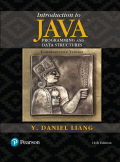
Concept explainers
ArrayList:
A list of object is stored in the “ArrayList”. Once an array list is created, the size of the array is fixed. Java gives the “ArrayList” class for storing an unlimited number of objects in a single list.
Creation of ArrayList:
ArrayList <String> x = new ArrayList<String>();
The above statement is an example of creation of “ArrayList”. The array object “x” is used to store the list of objects.
Explanation of Solution
Reason for not removing all the “Dallas” in the list:
“No”, the given code is not correctly removes all the elements in the arrayList.
Justification:
In the above sub part code,
- The variable “i” becomes “1” after removing one “Dallas” in the list and the variable “i” becomes “2” after removing two “Dallas” in the list. Then, the check the condition “2 < 2”. But it fails. So, the loop will end after removing two elements.
- Hence, the given code is correctly not removes all the elements in the arrayList. Because, the final array list contains “{“Houston”, “Dallas”}”.
Corrected code:
//Import the java package
import java.util.*;
//Define the class
public class Sample
{
//Define the main() method
public static void main(String[] args) throws Exception
{
//Declare the array list
ArrayList<String> list = new ArrayList<String>();
//Call add() method to add the string into list
list.add("Dallas");
list.add("Houston");
list.add("Dallas");
list.add("Dallas");
/*Check whether "i" is less than size of array list. */
for (int i = 0; i < list.size(); i++)
{
/*Check whether the condition is true. That is, removing the element from list by calling the remove() method. */
if(list.remove("Dallas"))
{
//Decrement the "i" value
i--;
/*Display the remaining elements in array list. */
System.out.println(list);
}
}
}
}
Explanation:
In the above code,
- Declare the array list in the name of “list”...
Want to see the full answer?
Check out a sample textbook solution
Chapter 11 Solutions
Introduction to Java Programming and Data Structures Comprehensive Version (11th Edition)
- Complete the JavaScript function addPixels () to calculate the sum of pixelAmount and the given element's cssProperty value, and return the new "px" value. Ex: If helloElem's width is 150px, then calling addPixels (hello Elem, "width", 50) should return 150px + 50px = "200px". SHOW EXPECTED HTML JavaScript 1 function addPixels (element, cssProperty, pixelAmount) { 2 3 /* Your solution goes here *1 4 } 5 6 const helloElem = document.querySelector("# helloMessage"); 7 const newVal = addPixels (helloElem, "width", 50); 8 helloElem.style.setProperty("width", newVal); [arrow_forwardSolve in MATLABarrow_forwardHello please look at the attached picture. I need an detailed explanation of the architecturearrow_forward
- Information Security Risk and Vulnerability Assessment 1- Which TCP/IP protocol is used to convert the IP address to the Mac address? Explain 2-What popular switch feature allows you to create communication boundaries between systems connected to the switch3- what types of vulnerability directly related to the programmer of the software?4- Who ensures the entity implements appropriate security controls to protect an asset? Please do not use AI and add refrencearrow_forwardFind the voltage V0 across the 4K resistor using the mesh method or nodal analysis. Note: I have already simulated it and the value it should give is -1.714Varrow_forwardResolver por superposicionarrow_forward
- Describe three (3) Multiplexing techniques common for fiber optic linksarrow_forwardCould you help me to know features of the following concepts: - commercial CA - memory integrity - WMI filterarrow_forwardBriefly describe the issues involved in using ATM technology in Local Area Networksarrow_forward
- For this question you will perform two levels of quicksort on an array containing these numbers: 59 41 61 73 43 57 50 13 96 88 42 77 27 95 32 89 In the first blank, enter the array contents after the top level partition. In the second blank, enter the array contents after one more partition of the left-hand subarray resulting from the first partition. In the third blank, enter the array contents after one more partition of the right-hand subarray resulting from the first partition. Print the numbers with a single space between them. Use the algorithm we covered in class, in which the first element of the subarray is the partition value. Question 1 options: Blank # 1 Blank # 2 Blank # 3arrow_forward1. Transform the E-R diagram into a set of relations. Country_of Agent ID Agent H Holds Is_Reponsible_for Consignment Number $ Value May Contain Consignment Transports Container Destination Ф R Goes Off Container Number Size Vessel Voyage Registry Vessel ID Voyage_ID Tonnagearrow_forwardI want to solve 13.2 using matlab please helparrow_forward
 New Perspectives on HTML5, CSS3, and JavaScriptComputer ScienceISBN:9781305503922Author:Patrick M. CareyPublisher:Cengage Learning
New Perspectives on HTML5, CSS3, and JavaScriptComputer ScienceISBN:9781305503922Author:Patrick M. CareyPublisher:Cengage Learning EBK JAVA PROGRAMMINGComputer ScienceISBN:9781337671385Author:FARRELLPublisher:CENGAGE LEARNING - CONSIGNMENT
EBK JAVA PROGRAMMINGComputer ScienceISBN:9781337671385Author:FARRELLPublisher:CENGAGE LEARNING - CONSIGNMENT C++ Programming: From Problem Analysis to Program...Computer ScienceISBN:9781337102087Author:D. S. MalikPublisher:Cengage Learning
C++ Programming: From Problem Analysis to Program...Computer ScienceISBN:9781337102087Author:D. S. MalikPublisher:Cengage Learning Systems ArchitectureComputer ScienceISBN:9781305080195Author:Stephen D. BurdPublisher:Cengage LearningProgramming Logic & Design ComprehensiveComputer ScienceISBN:9781337669405Author:FARRELLPublisher:Cengage
Systems ArchitectureComputer ScienceISBN:9781305080195Author:Stephen D. BurdPublisher:Cengage LearningProgramming Logic & Design ComprehensiveComputer ScienceISBN:9781337669405Author:FARRELLPublisher:Cengage Microsoft Visual C#Computer ScienceISBN:9781337102100Author:Joyce, Farrell.Publisher:Cengage Learning,
Microsoft Visual C#Computer ScienceISBN:9781337102100Author:Joyce, Farrell.Publisher:Cengage Learning,





